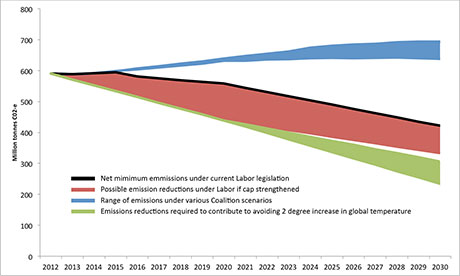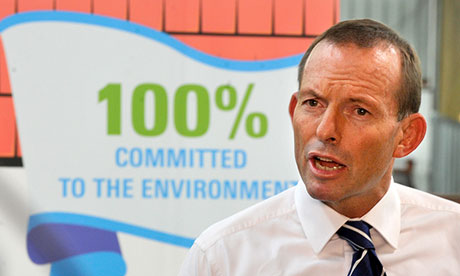Tony Abbott will have to find at least another $4bn for his climate policy or else break his pledge to cut emissions by 5% by 2020 and instead allow them to increase by 9%, according to new modelling suggesting the Coalition's Direct Action plan cannot work.
The Coalition insists it will provide no more than the money it has allocated to buy emission reductions from polluters who voluntarily apply to its emissions reduction fund – $2.5bn over the next four years – and, according to figures in the original 2009 policy document, almost $5bn by 2020.
But a devastating analysis by the Climate Institute, based on modelling from Sinclair Knight Merz/MMA and Monash University's Centre of Policy Studies, found at least $4.07bn more would be required to meet the target.
Without the extra money, the modelling shows, the Coalition would have no hope of meeting the international pledge of a minimum 5% emissions reduction by 2020, agreed by both the main parties, and would instead preside over an increase in Australia's emissions of 9%.
This would be equivalent to doubling the number of cars on Australian roads, the analysis says.
On Wednesday Abbott refused to address the modelling's findings, saying: "I simply don't accept the report."
He added: "Greg Hunt [the Coalition climate spokesman] is confident, as I am, that we can purchase sufficient emissions from the funding envelope we have provided."
And Abbott said buying emission reductions on the international market would amount to Australia "shirking our environmental duty".
"If we are fair dinkum ... we have to do it here in Australia."
Abbott has repeatedly attacked Labor's carbon price plan – including during Sunday night's leaders debate – because it would allow Australia to buy a proportion of its emission reductions overseas, which means while emissions would be significantly lower domestically than if nothing was done, they would still be higher in 2020 than they were in 2000.
"This tax is all economic pain for no environmental gain," Abbott told parliament in a speech on the carbon pricing bills.
He added: "It won't even reduce emissions ... What we are supposed to be doing, if we are to reduce our emissions by 5% on 2000 figures by 2020 is getting it down to 530m tonnes. That's what we're supposed to be doing.
"But the government's own figures don't say that we are reducing our emissions by 5%. The government's own figures say that we are in fact increasing our own domestic emissions from 578m tonnes to 621m tonnes.
"Now, what's the point? What is the point of all the pain of this carbon tax if our emissions are actually going to increase?"
 Carbon emissions predicted under various policy outcomes. Click here to enlarge. Photograph: Guardian/TCI
Carbon emissions predicted under various policy outcomes. Click here to enlarge. Photograph: Guardian/TCI
Embarrassingly for Abbott, the modelling shows that with its current capped amount of money his own policy would in fact result in 40% less domestic emission reduction than Labor's.
Under Labor, domestic emissions would fall by 287m tonnes of carbon dioxide (with 184m tonnes bought offshore by the big polluters). Under Direct Action domestic emissions would fall by 204m tonnes, the modelling shows.
The only way the Coalition could meet the 2020 target without massive new spending would be to copy Labor's policy and buy permits overseas. That would reduce the cost from $4bn to $190m.
But Abbott has insisted the Coalition will not buy offshore permits, saying the European Union trading scheme is "riddled with scamming" and offshore purchases amount to "a massive transfer of wealth from this country to carbon traders overseas".
Another huge problem for the Coalition policy is that cutting emissions further than 5% would be prohibitively expensive – exactly the charge levelled by former Liberal leader Malcolm Turnbull when he explained in 2011 that continuing to use a big government taxpayer-funded scheme to reduce emissions in the long term would "become a very expensive charge on the budget in the years ahead".
According to the modelling even while spending $88bn dollars from 2014 to 2050 on Direct Action-type policies emissions would rise by around 45%.
It found that even if the Coalition left the renewable energy target unchanged when it reviewed the policy in 2015, the abolition of a whole economy carbon price would reduce the proportion of renewable energy used in Australia from 24% to 22%.
And while Labor's scheme would reduce Australia's reliance on coal-fired power over time, under the Coalition's plan it would increase.
Under Labor coal-fired power would account for 61% of electricity generation in 2020, 53% in 2030 and 31% in 2050, assuming carbon capture and storage was viable. Under the Coalition plan, which makes it voluntary for polluters to reduce emissions, coal-fired power would be 64% of our electricity in 2020, 66% in 2030 and 69% in 2030.
Pointing to an analysis by the International Monetary Fund that failure to price emissions effectively subsidises polluters, the analysis calculates the Coalition's policy represents an effective subsidy of $50bn for polluting industries by 2020.
Under both the Coalition's and Labor's climate plans, the economy and employment would continue to grow. But both economic and employment growth would be slightly stronger under the Coalition.
According to the Climate Institute's Erwin Jackson, this is not a fair comparison.
"The economy and jobs grow strongly under both scenarios. Directly comparing the growth numbers isn't fair because the Labor policy is achieving Australia's target, whereas the Coalition policy isn't."
Gross national product per person would increase 8.8% under Labor by 2020 and 9.2% under the Coalition.
The Climate Institute says it is worried that a program based on annual budget outlays is always susceptible to budget cuts – especially since the Coalition has said it will review and possibly revise Direct Action in 2015.
The Coalition had said it would provide capped funding of $300m in 2014-15, $500m in 2015-16 , $750m in 2016-17, $1bn in 2017-18 and $1.2bn in 2018-19 and and 2019-20, and the analysis assumes this will be the case. But Coalition climate spokesman Hunt has recently only been talking about the commitments in the first three years. If long-term funding is lower than promised, the Coalition emissions reductions would obviously fall short by even more.
The modelling is broadly consistent with several previous analyses, including by Ernst & Young, Allens and the Treasury.
Given the huge uncertainties raised about how much it would cost and what it would achieve, the Climate Institute is calling on the Coalition to keep Labor's emissions trading scheme at least until it gets new independent analysis to prove it can work.



